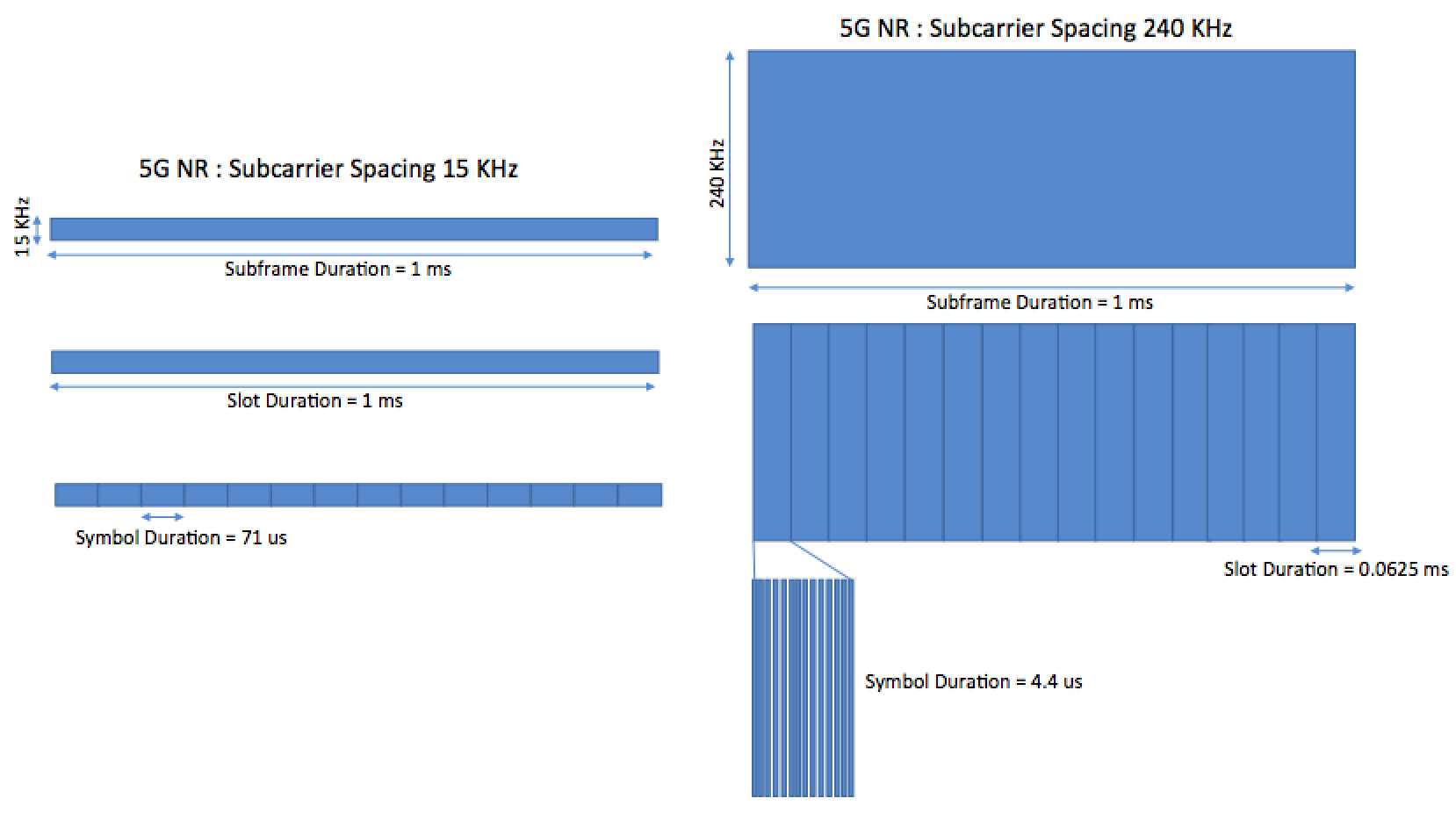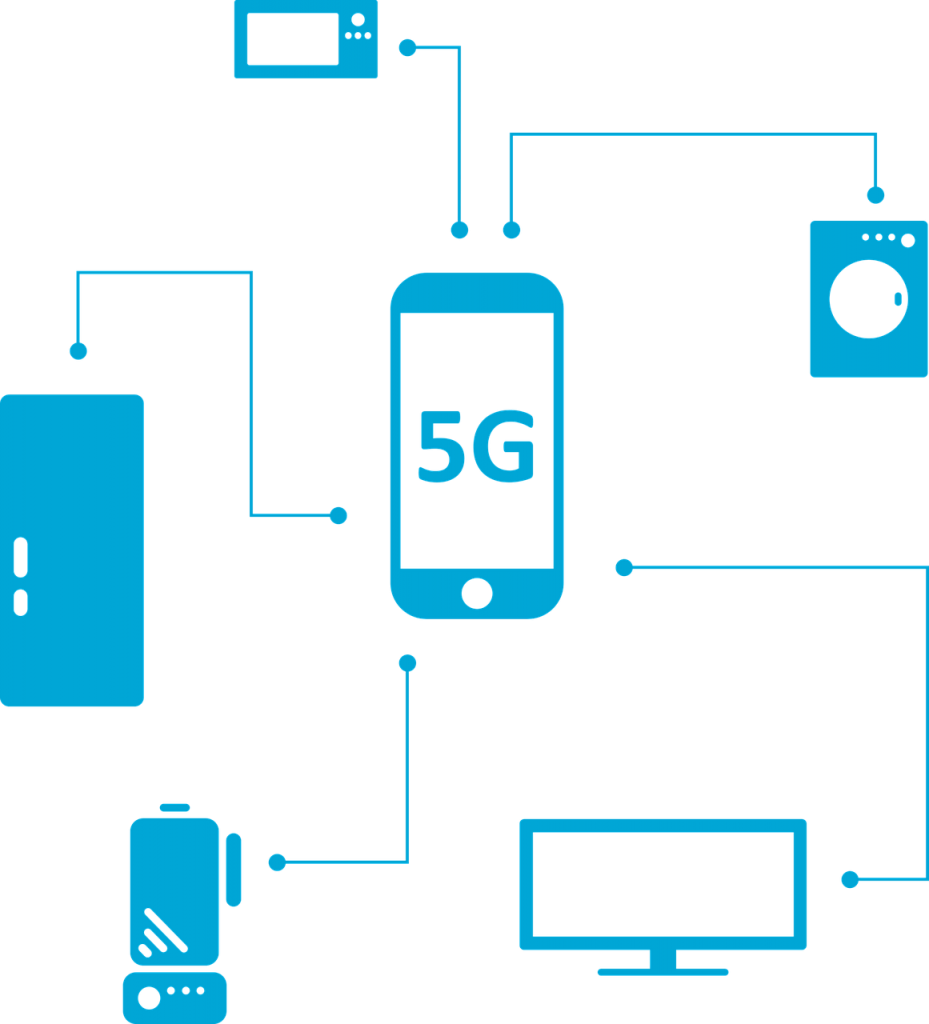Recently, 3GPP has shared the Non-StandAlone 5G New Radio (NR) details in Rel15. Naturally, everyone wants to know what changes and enhancements it holds to achieve the high throughput and low latency targets. So, I thought that I would write a short article on the new 5G specifications explaining the additions in the structure and how it provides gains over the current 4G specifications.
5G Major Targets : For 5G NR, there many targets that it needs to achieve but some of the most important targets are higher throughput and low latency.
URLLC (Ultra Reliable Low Latency Communication) : URLLC is one of the most important target for 5G NR. This target requires 5G to have an E2E latency of less than 1ms which sounds pretty tough to achieve considering that the current 4G or 4.5G LTE has a latency of around 25 to 30ms and it can even increase to above 100ms in case of congestion. In order to reduce the latency, the 5G NR introduces a scale-able or dynamic structure where the symbol length can change along with the slot length. Let’s have a look at this structure.

A shorter symbol duration causes an increase in subcarrier spacing Δf. The relation between symbol duration and subcarrier spacing is given by:
Symbol duration = 1 / Δf (plus a CP is added to it)
This shows that for a shorter symbol duration, we will need more bandwidth for the same number of carriers. As seen in the table, the usual 15 KHz that is used by 4G gives 14 symbols per slot with a symbol length of around 71 microseconds while the symbol length of 4.4 microseconds can be achieved with a subcarrier spacing of 240 KHz. This will provide around 16 slots in a single subframe.

Asynchronous HARQ : Since we have a flexibility of using a much smaller symbol duration so 5G NR also introduces a HARQ PDSCH Feedback Timing Indicator. This field is introduced in DCI Format 1_0 and 1_1 and tells the UE where it needs to send the HARQ feedback for the downlink data that it received. UE sends the HARQ retransmission based on this instruction over the PUCCH. Since, we have a slot length of only 0.0625 ms so if UE sends the ACK in slot N+4, the overall time would be around 0.0625*4 which will be around 0.25ms. However, since the HARQ feedback is asynchronous which means that the eNB informs the UE when and where to send the HARQ feedback, it will be mostly even lesser than this. So, this structure ensures a much smaller latency over the air which ensures that the URLLC target is achieved.
eMBB (Enhanced Mobile BroadBand) : eMBB is the throughput oriented part of the 5G NR. It is stated that 5G NR requires to achieve throughput targets above 1 Gbps initially and upto 20 Gbps in later phase and this also needs a lot of work.
Bandwidth : The current 5G specifications support 256 QAM but this was also supported by LTE, however, there aren’t many UEs in the market that support it commercially. Secondly, 5G supports a single carrier of upto 275 RBs while LTE only supported a single carrier of 100 RBs. This will give a big boost as this is about 2.75 times more bandwidth. Moreover, if Carrier Aggregation is done with a couple of such carriers, it will provide a huge throughput gain. As of now, around 16 carriers can be aggregation in 5G NR and a total aggregated bandwidth can go upto 1 GHz. This is much higher than the usual 3CC CA seen in LTE with 60MHz or 5CC CA with 100Mhz.
Massive MIMO : Another important factor is the MIMO functionalities for 5G NR which has introduced an increase in antenna ports which will provide much higher throughput gains based on SU-MIMO, MU-MIMO and beamforming. There are around 8 orthogonal DMRS sequences defined which can support SU-MIMO.
Reference Signals : The Reference Signals in 5G NR are also different from LTE. In LTE, there are cell specific reference signals which are always enabled and cause most of the downlink interference. In 5G NR, such reference signals are removed and RS are only used when the UE has data allocation. Basically, they are more like UE specific RS and act like DMRS. There are other types of RS as well like phase tracking reference signals which are used to counter phase noise at higher frequencies. This kind of structure will reduce the downlink interference and consequently improve the channel quality resulting in better spectral efficiency and capacity.
A question may arise that if there are no cell specific reference signals then how the UEs will get the RSRP during initial access or reselection since they will not any allocation at that time. The answer lies in the fact that 5G NR uses a PSS/SSS/PBCH block structure. The PBCH has it’s own set of reference signals which will always be present in the PBCH so the UE while reading the PSS/SSS/PBCH block should be able to ascertain a RSRP value from the PBCH DMRS.
I will share more on 5G in coming articles, so stay tuned and don’t forget to subscribe.
In case of any queries or feedback, please drop a comment below and I would love to respond and help. Also, if this has been helpful, then please subscribe to our Youtube channel – Our Technology Planet for more exciting stuff and videos.
References
3GPP 38211 38212 38213
Ali Khalid
Latest posts by Ali Khalid (see all)
- 5G Coverage Expansion Analysis – Find The Optimal 5G Coverage Threshold For Your Network - November 9, 2024
- 5G Coverage Expansion - November 9, 2024
- 5G SA Cell Search & Network Entry Matrix - July 18, 2023

Isn’t that Number of slots in one subframe is 2 in LTE? So according to your table above, it should be 2 for 15KHz and the rest suppose to be 4, 8, 16 & 32.
Slot length also need to be corrected to 0.5 ms. There are 10 subframes in the LTE Radio Frame. Each subframe consists 2 slots with 0.5 ms.
If you say subframe instead of slot then above your table details are correct.
The table is for 5G, not for 4G. In 5G, the slot length is 1 ms for SCS of 15 kHz.
I already explained the LTE frame structure in another article “https://ourtechplanet.com/lte-frame-structure-made-simple/”. You can refer to that if you are interested in the 4G frame.
There is one slot in 5G and its duration is 1 ms – unlike 4G.
Nice post, Keep posting on the 5G basics . Also share the key difference between LTE & 5G & hows its achieved .
Thank you for posting this…it is a short but sweet technical spec on how 5G NR can achieve the insane 1ms latency
Very interesting article Ali. Thanks for sharing. We are achieving some very interesting use cases already with private 4G. With a local MEC core we can keep the latency low enough for port automation applications for example, or autonomous vehicles. The latency and through put targets for 5G will really open up the possibilities.
very good and informative, thanks
Thanks Neal 🙂
Nice.. Article on 5G.. Ali..atlst it creates a frame in the mind that 5g would be like this.. So 5G can be accomodated from 6RB to 275 RBs.. right.. kindly publish another article for frame structure of 5G..
Good start
Thanks
Hi Alì!
Thank you very much for this useful insight! Keep writing! 🙂
Thanks Marco 🙂
Good article Ali. If possible, please do write something about 5G proposed frame structure.
Thanks, sure I will 🙂
“This shows that for a shorter symbol duration, we will need more bandwidth for the same number of carriers”
wouldn’t this be a disadvantage (less RBs for the same BW)
And shorter symbol duration is contributing to latency duration reduction , right ?
Symbol transmission time is reduced
correct me if am confusion myself
Thanks
Yeah, it is required for latency reduction so this format can be used for services that require very low latency and services requiring high throughput can use the 15KHz format.